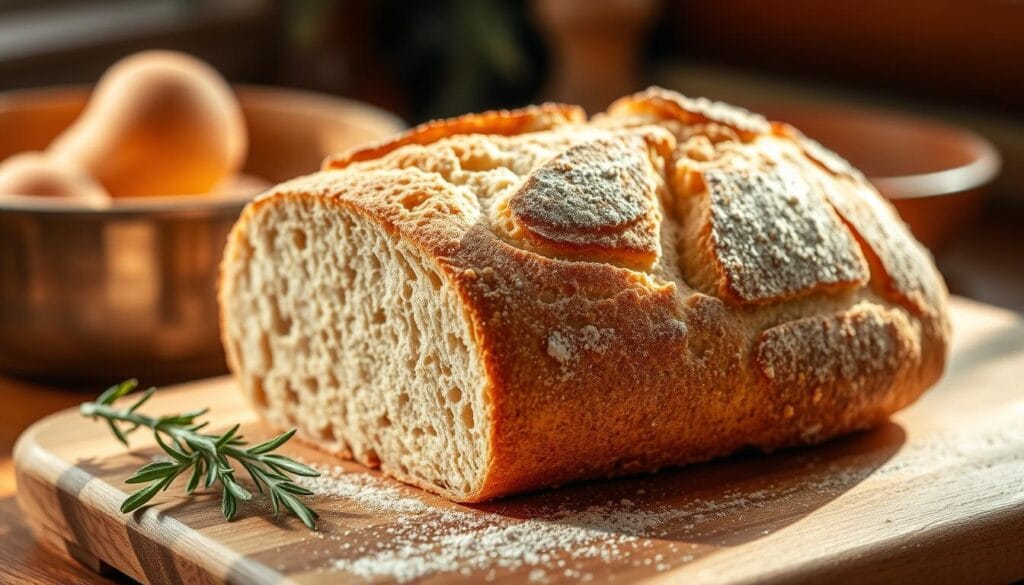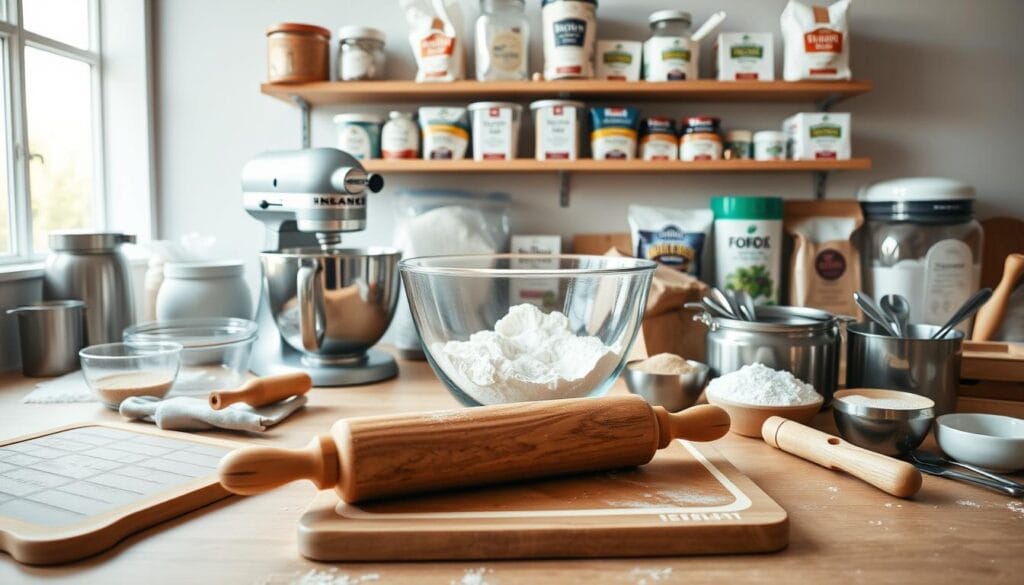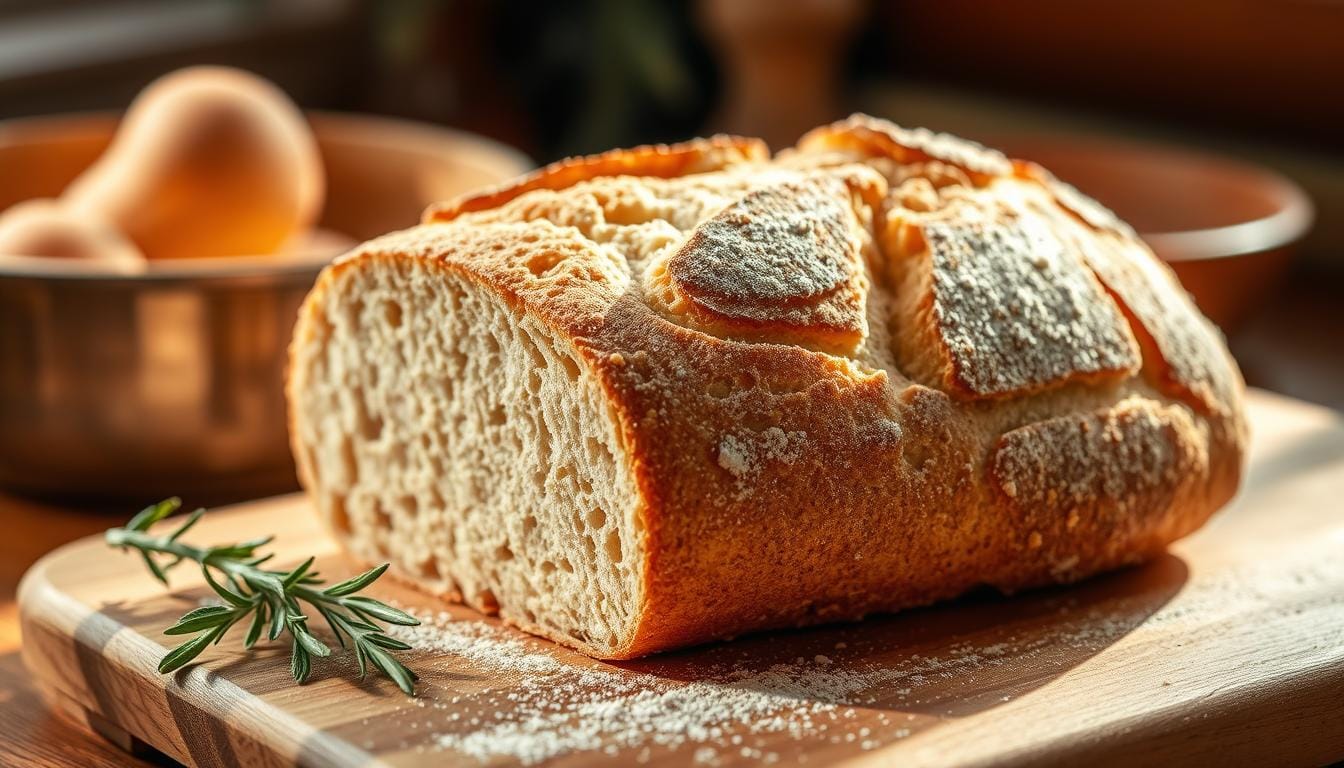2025
“Homemade Gluten-Free Sourdough Bread: A Step-by-Step Guide to Perfecting Your Loaf”

Baking gluten-free sourdough bread might seem hard, but it’s not. With the right steps, anyone can make tasty, tangy bread at home. This guide will show you how to make perfect gluten-free sourdough, just like the ones from bakeries.
Gluten-free baking has gotten much better in recent years. Now, people with dietary needs can enjoy fresh, artisan-style bread. This recipe will help you make top-notch sourdough in your kitchen, whether you have celiac disease or just want to try something new.
It’s not just about following a recipe to make gluten-free sourdough bread. It’s about knowing the science of fermentation, picking the right ingredients, and mastering techniques. These steps bring out amazing flavor and texture in your bread.
Key Takeaways
- Gluten-free sourdough is accessible to all skill levels
- Fermentation enhances bread’s nutritional profile
- Proper technique matters more than complex ingredients
- Homemade bread offers superior taste and quality
- Gluten-free baking can be enjoyable and rewarding
Understanding the Science Behind Gluten-Free Sourdough Fermentation
Gluten-free sourdough is a world of transformation. Your sourdough starter is alive, made of flour and water. It’s a mix of microorganisms that make tasty, easy-to-digest foods.

The magic starts with tiny organisms. They turn simple ingredients into something amazing. Unlike commercial yeasts, wild yeasts add depth and complexity to your baking.
The Role of Wild Yeast in Fermentation
Wild yeast is key to flavor and texture. These tiny creatures break down carbs and make nutrients easier to get. Your gluten-free sourdough starter becomes a nutritional powerhouse.
- Captures natural yeasts from the environment
- Develops complex flavor profiles
- Increases nutrient bioavailability
Benefits of Natural Fermentation Process
Fermented foods are great for your health. The sourdough starter process reduces anti-nutrients. This makes gluten-free bread easier to digest and more nutritious.
How Bacteria Creates That Perfect Tang
Bacteria are behind sourdough’s tangy taste. Lactobacillus bacteria make lactic acid, giving bread its sour taste. This creates a flavor that commercial breads can’t match.
Every sourdough starter tells a unique story of microbial collaboration and culinary magic.
Essential Equipment and Tools for Baking Success

Making artisan bread needs the right tools, especially for gluten-free baking. Your kitchen setup greatly affects your homemade sourdough bread’s quality.
To begin your gluten-free baking, you’ll need some key equipment. It turns your home kitchen into a professional bakery:
- Mixing Bowls: Choose glass or ceramic bowls for even temperature
- Digital Kitchen Scale: Accurate measurements are crucial in gluten-free baking
- Proofing Basket (Banneton): Shapes your bread and adds beautiful patterns
- Dutch Oven or Baking Stone: Gives a perfect crust and even heat
- Scoring Knife (Lame): Creates professional bread designs
You can find budget-friendly alternatives for most baking tools. A regular colander can replace a proofing basket. A cast-iron skillet works as a baking stone substitute.
Quality gluten-free baking tools don’t have to be expensive. Start with basic tools and upgrade as you improve your bread-making skills.
“The right tools transform home baking from a challenge to a delightful experience.” – Professional Baker
Each tool has a specific role in making your gluten-free sourdough perfect. Knowing their purpose makes you a more confident baker.
Creating Your Gluten-Free Sourdough Starter from Scratch
Making a gluten-free sourdough starter is a fun journey into fermentation. It’s different from traditional starters because it needs special care and the right ancient grains. This creates that tangy flavor and strong culture.
Selecting Your Flour Blend
Choosing the right flour mix is key for a great sourdough starter. Here are some top ancient grains and gluten-free options:
- Teff flour
- Sorghum flour
- Millet flour
- Buckwheat flour
- Brown rice flour
Starter Feeding Rhythm
Your sourdough starter needs regular care. Set up a feeding schedule to keep it lively and active. Feed it daily with fresh gluten-free flour and filtered water.
| Starter Age | Feeding Frequency | Flour Ratio |
|---|---|---|
| 0-7 Days | Twice Daily | 1:1:1 (Starter:Water:Flour) |
| 1-2 Weeks | Once Daily | 1:2:2 (Starter:Water:Flour) |
| Mature Starter | Every 5-7 Days | 1:3:3 (Starter:Water:Flour) |
Recognizing a Healthy Starter
A healthy sourdough starter shows clear signs of fermentation. Look for these signs:
- Consistent bubbling throughout the mixture
- Pleasant, slightly sour aroma
- Doubling in volume within 4-8 hours after feeding
- Smooth, elastic consistency
Be patient when making your sourdough starter. Each batch of ancient grains is different. Watch closely and adjust your methods as needed.
Best Gluten-Free Flour Blends for Perfect Sourdough
Gluten-free baking needs the right flour blends for tasty sourdough bread. Knowing about wheat alternatives is crucial for the perfect texture and flavor.
When looking for gluten-free flour blends, aim for ones that offer structure and taste. Some great wheat alternatives include:
- Rice flour: Provides lightness and neutral flavor
- Sorghum flour: Adds nutty undertones and improved texture
- Millet flour: Contributes softness and mild sweetness
- Buckwheat flour: Delivers rich, earthy notes
To make the perfect gluten-free flour blend, mix different ingredients to match wheat’s qualities. Starches like tapioca and potato help bind and keep moisture in gluten-free baking.
| Flour Type | Characteristics | Best Uses |
|---|---|---|
| Rice Flour | Light, neutral flavor | Base for most blends |
| Sorghum Flour | Nutty flavor, good structure | Primary flavor component |
| Millet Flour | Soft texture, slight sweetness | Improving crumb quality |
Try different ratios to discover your ideal gluten-free sourdough mix. Begin with 60% rice flour, then mix in other flours for depth and complexity.
Pro tip: Always include a binding agent like xanthan gum to help replicate gluten’s structural properties in your sourdough.
Master Recipe: Gluten Free Sourdough Bread
Making the perfect gluten free sourdough bread needs precision, patience, and passion. This recipe will guide you to create a delicious loaf that’s as good as bakery bread.
Essential Ingredients for Success
Starting with top-notch ingredients is key to making great gluten free sourdough bread. Each ingredient is important for flavor and texture.
- 1½ cups gluten-free flour blend
- ½ cup active gluten-free sourdough starter
- ¾ cup warm water
- 2 large eggs
- 3 tablespoons olive oil
- 1 teaspoon sea salt
- 1 tablespoon honey
Mixing Techniques for Perfect Texture
Mixing gluten free sourdough bread needs a gentle touch. Start by mixing dry ingredients in a big bowl. Make a well in the center and add wet ingredients, including sourdough starter.
“The secret to great artisan bread is understanding how ingredients interact.” – Professional Baker
Proofing and Shaping Your Bread
Proofing gluten free sourdough bread is crucial. Unlike wheat bread, gluten-free dough needs longer to develop structure and flavor.
- Mix ingredients until smooth
- Cover and let rest in warm area for 4-6 hours
- Gently shape into desired loaf form
- Place in proofing basket
- Refrigerate overnight for enhanced flavor
Your gluten free sourdough bread will have a crisp crust and soft crumb. It shows the power of fermentation and careful technique.
Troubleshooting Common Baking Challenges
Gluten-free baking can be tricky, but knowing common problems helps. You can make tasty, healthy bread. Let’s look at the usual issues with gluten-free sourdough bread.
Density and Texture Challenges
Dense or gummy bread often comes from wrong moisture levels. Finding the right amount of water is key. Here are some tips to better your bread’s texture:
- Adjust liquid amounts slowly
- Use a digital kitchen scale for exact measurements
- Try different gluten-free flour mixes
Rise and Fermentation Issues
Not getting enough rise can be tough. Your sourdough starter is vital for volume and texture in gluten-free bread.
| Problem | Potential Cause | Solution |
|---|---|---|
| No Rise | Weak Starter | Refresh starter more often |
| Flat Bread | Low Temperature | Proof in warmer spots |
| Dry Texture | Incorrect Hydration | Add more liquid |
Environmental Factors
Your baking space greatly affects gluten-free sourdough. Altitude, humidity, and temperature all play a part. Always adjust your methods based on your area’s conditions.
Pro tip: Keep a baking journal to track your experiments and improvements in gluten-free baking techniques.
Mastering gluten-free sourdough takes patience and practice. Every loaf gets you closer to perfect, healthy baking.
Tips for Achieving the Perfect Crust and Crumb
Making the perfect artisan bread is more than just mixing ingredients. Your gluten free sourdough bread can go from good to amazing with a few expert tips. These tips will take your home baking to the level of a professional bakery.
Understanding the details that make bread exceptional is key. Here are some tips to make your gluten free sourdough bread look and taste like it was made by a pro.
Precision Temperature Control
Temperature is crucial for your bread’s character. Each baking stage needs a specific temperature:
- Starter fermentation: 70-75°F
- Proofing: 75-80°F
- Baking: 450-475°F
Creating Magical Steam
Steam is key for a crispy, golden crust. Bakers use different methods to create it:
- Preheated cast-iron pan with water
- Spray bottle misting
- Baking dome or Dutch oven
Scoring: The Baker’s Signature
Scoring is more than just for looks. It helps the bread expand and creates patterns. Here are some sharp techniques:
| Scoring Pattern | Visual Effect | Bread Expansion |
|---|---|---|
| Single Slash | Simple, Clean | Moderate |
| Wheat Stalk | Intricate | Maximum |
| Crosshatch | Geometric | Controlled |
“Bread scoring is where science meets art in baking.” – Professional Baker’s Wisdom
With practice, you’ll find your own way to make stunning gluten free sourdough bread. It will be just as good as what you buy from a bakery.
Storing and Preserving Your Artisan Bread
Keeping your homemade gluten-free sourdough artisan bread fresh is key. It’s all about preserving that tasty flavor and soft texture. If you bake often, you’ll want to keep your bread fresh for days.
For the best results, store your bread at room temperature. Glass containers or bread boxes are perfect for this. They keep your bread moist but not soggy.
- Store bread in a cool, dry place away from direct sunlight
- Use a breathable container to prevent moisture buildup
- Keep bread at room temperature for up to 3 days
Freezing is great for longer storage. Slice your bread before freezing for easier thawing. Wrap each slice in parchment paper, then bag them in a freezer-safe bag.
| Storage Method | Duration | Best Practices |
|---|---|---|
| Room Temperature | 2-3 days | Use bread box or glass container |
| Refrigeration | Not recommended | Can dry out bread quickly |
| Freezer Storage | Up to 3 months | Wrap individually, thaw at room temperature |
To reheat frozen bread, thaw it at room temperature first. Then, warm it in the oven. This will bring back that fresh-baked taste you love.
Health Benefits of Fermented Gluten-Free Bread
Fermented gluten-free sourdough bread is a game-changer for those on a celiac diet. It’s not just bread; it’s a nutritional powerhouse. The fermentation process breaks down hard-to-digest proteins, making it easier for people with sensitive stomachs to digest.
It’s great for your gut health too. The fermentation creates a probiotic-rich environment. This supports the growth of good bacteria. Vegan bakers will love how it boosts nutrient absorption and reduces inflammation.
Studies show that long fermentation lowers bread’s glycemic index. This means your blood sugar stays stable. It’s perfect for those with dietary restrictions, offering balanced nutrition in a delicious package.
Adding fermented gluten-free sourdough to your diet is a smart choice. It’s not just tasty; it’s packed with nutrients. The fermentation process enhances the absorption of minerals and vitamins, making it a better choice than regular gluten-free bread.
FAQ
Is gluten-free sourdough bread really possible to make at home?
Yes, it is! Making gluten-free sourdough bread at home is doable. You just need the right ingredients and techniques. Understanding how different flours work and mastering fermentation is crucial.
What flours work best for gluten-free sourdough?
Sorghum, rice flour, millet, and buckwheat are top choices. These ancient grains offer great structure and flavor. A mix of 2-3 flours is best to get the wheat bread feel and taste.
How long does it take to create a gluten-free sourdough starter?
It takes 7-10 days to make a gluten-free sourdough starter. You’ll need to feed it daily and be patient. It will develop wild yeast and bacteria, giving it a tangy flavor.
Can people with celiac disease eat gluten-free sourdough bread?
Yes, but with some precautions. Use 100% gluten-free ingredients and a dedicated kitchen to avoid cross-contamination. Always talk to a healthcare professional before trying new foods.
How is gluten-free sourdough different from regular sourdough?
Gluten-free sourdough needs special flour blends and binders like psyllium or xanthan gum. The fermentation process is similar, but you’ll need to adjust mixing and proofing for gluten-free flours.
What equipment do I need to make gluten-free sourdough bread?
You’ll need a digital kitchen scale, mixing bowls, a proofing basket, a Dutch oven or baking stone, a thermometer, and a bench scraper. These tools help you make professional-quality bread at home.
How long will homemade gluten-free sourdough bread stay fresh?
Homemade gluten-free sourdough stays fresh for 3-4 days at room temperature. Store it in a bread box or sealed container. You can keep it longer by refrigerating or freezing it.
Is gluten-free sourdough more nutritious than regular bread?
Yes, it can be. The fermentation process breaks down anti-nutrients, making nutrients more absorbable. It also creates beneficial probiotics and can be easier to digest for many.
Can I make vegan gluten-free sourdough bread?
Definitely! Most gluten-free sourdough recipes are vegan. You can make a plant-based sourdough using gluten-free flours, water, salt, and your starter without animal products.
What’s the most challenging part of making gluten-free sourdough?
The biggest challenge is getting the right texture without gluten. Gluten-free doughs need precise hydration, mixing, and proofing. Patience and practice are essential to master it.

